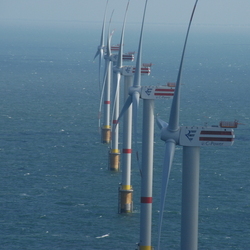 NRG Bluewater's suspension of all offshore wind energy development earlier this week is a stark reminder that, for all of its potential, offshore wind remains fraught with risk.
NRG Bluewater's suspension of all offshore wind energy development earlier this week is a stark reminder that, for all of its potential, offshore wind remains fraught with risk.
Many understand the risky nature of offshore wind, particularly in regard to development in the U.S., where the offshore wind industry is still in its embryonic stages. Still, when outside influences begin to put bellwether projects – such as NRG Bluewater's 200 MW Offshore Wind Park, which was planned off the coast of Delaware – in serious jeopardy, it provides reason for pause.
After all, Bluewater Wind has been developing the Delaware site since summer 2006 and has assets that would be attractive to an investor, most notably a long-term power purchase agreement (PPA) with Delmarva Power and state approval for the project's first round of permits.
However, even with a signed PPA in place, the company has not been successful in luring an investor.
As David Crane, the company's president and CEO, spelled out in a statement, the outlook for offshore wind and for the Delaware project has changed dramatically in the time since NRG acquired Bluewater Wind in November 2009.
‘In particular, two aspects of the project critical for success have actually gone backwards: the decisions of Congress to eliminate funding for the Department of Energy's loan-guarantee program applicable to offshore wind, and the failure to extend the federal investment and production tax credits for offshore wind, which expire at the end of 2012 and which have rendered the Delaware project both unfinanceable and financially untenable for the present,’ he said.
Such a turn of events has put companies in the unenviable position of either waiting for the market to turn around or simply cutting their losses.
‘Projects need to make economic sense to be successful,’ explains Brian Redmond, managing director at Boston-based CP Energy. ‘Offshore wind will be competitive at the right scale and with the right technology.’ He notes that the industry needs to develop the local supply chains that will create jobs and lower costs.
‘That process is under way, but it will take time to put these capabilities and resources in place,’ Redmond explains. "The bottom line is that offshore wind is the only way to deliver large-scale clean energy to East Coast markets, where land use is highly competitive and new transmission is hard to permit.’
‘Investors get this broad view, but now they want to see bite-size investment opportunities that both stand on their own and build the capabilities for larger-scale investments in offshore wind,’ he adds.
While NRG Bluewater seeks an investor, Peter Mandelstam, the company's founder and president, says the success of offshore wind in Europe – and, increasingly, in China – is the result of a marketplace coalescing around stable policy.
‘Europeans have a different perspective,’ he explains. ‘There are 9,700 MW of steel in the water. It's a question of priorities and where policy really does affect the way business allocates their money,’ he says.
Some industry observers, such as Jim Lanard, president of the Offshore Wind Development Coalition, are still hopeful that such a deal can still be brokered.
‘I wouldn't write off Peter,’ Lanard cautions. ‘He is at his best when things are at their worst.’
Despite the challenging market conditions facing offshore wind, Lanard says, ‘We need people to continue taking risks. We need pioneers.’



